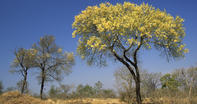
Name
Knob thorn (Acacia nigrescens)Description
The knob thorn tree is characterised by the shape of its leaves. Each leaf comprises of four to six leaflets, is rather large with lopsided bases and double pinnately compound. The rachis bends backwards and has small spines.
This tree is deciduous, losing its leaves in winter and early spring. New leaves can be bright red in colour. In some cases, individual species of knob thorn trees do not grow knobs on their branches or trunks. It ranges from 5 m to 18 m in height and is fire-resistant. The common name for the knob thorn tree in Afrikaans and English refers to its typically knobbed thorns.
Knob Thorn Flowers and Fruit
The knob thorn tree erratically blooms between the months of August and November. When in bud form, the flowers are reddish-brown, becoming cream-white in colour once fully open. These fragrant flowers are grown in the shape of a spike about 100 mm long.
The fruit of the knob thorn tree is a pod, measuring about 100 mm in length and 13 to 25 mm in width. The tree’s Latin name likely refers to the pods turning black in colour as they ripen – nigrescens meaning ‘becoming black’. These pods are a food source to giraffes and other animals.
The knob thorn tree’s branches, shoots and leaves are eaten by the elephant, and the kudu browses on its leaves and shoots. Its flowers are eaten by giraffes, baboons and monkeys.
Knob Thorn Uses
In its natural habitat, this tree is home to birds by hole-nesting. Its wood is hard and resistant to termites and drought, but frost-tender. The wood of the knob thorn tree has been used to make mine props and posts as it is a very durable timber.
Although it is not often used for furniture, it has incredible impact strength and is therefore used for parquet flooring. This tree is also a good subject for bonsai practice.